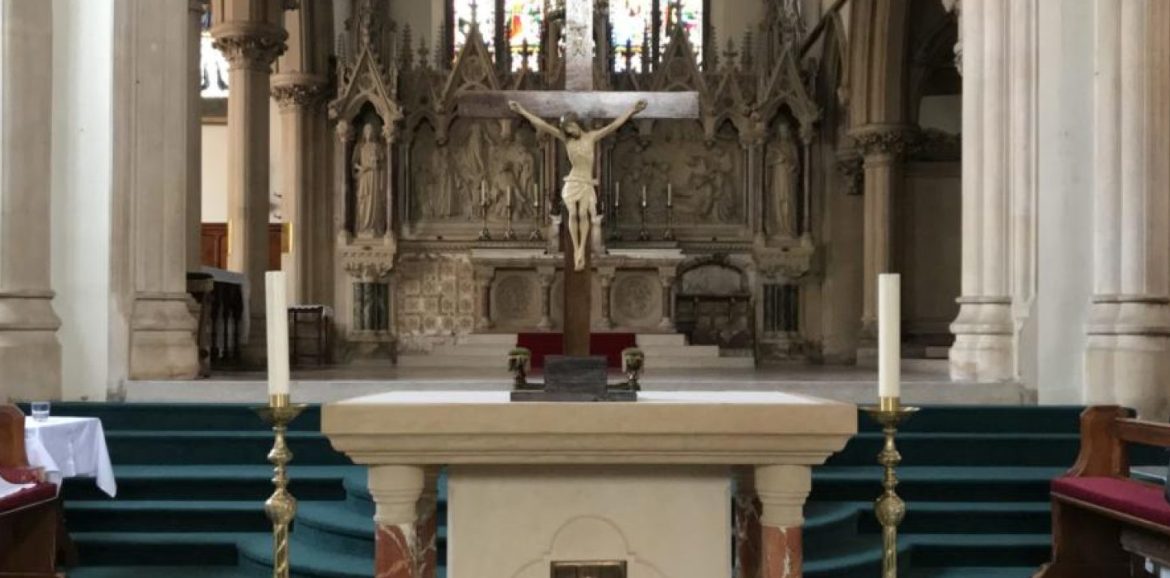Just a Thought
The obedience of Abraham, ready to sacrifice his son at God’s command, is of great importance in the tradition and piety of Jews, Moslems, and Christians. The biblical account of this episode is remarkably restrained. Nothing evokes the inner drama of this father, from whom such a sacrifice is demanded, or of the son. Only Abrahams’ obedience—’Ready’— and God’s intervention are described.
For the Old Testament, Abraham behaved in this circumstance as the complete model of the just one who, with total trust in God, obeys him, whatever is asked. In Isaac—Abraham’s only son—rested the promise of posterity made to the patriarch. Abraham does not doubt God’s faithfulness for a single instant.
The New Testament has retained the lesson of faith given by Abraham. It is a text from the Letter to the Hebrews that gave form to the Christian reading of Abraham’s sacrifice.
‘By faith Abraham, when put to the test, offered up Isaac, and he who had received the promise was ready to offer his only son, of whom it was said ‘Through Isaac descendants shall bear your name.’ He reasoned that God was able to raise even from the dead, and he received Isaac back as a symbol.’ (Heb 11:17-19)
On the basis of this text, most Father’s of the Church have seen in Isaac the prophetic figure of Christ. This is also why the sacrifice of Abraham is often represented on frescoes, in particular those of the Roman cemeteries —the catacombs—and sarcophagi. Eucharistic Prayer 1 (The Roman Canon) places side by side the sacrifice of Abraham and the offering of the Eucharist: ‘Look with favour on these offerings and accept them as once you accepted the sacrifice of Abraham, our father in faith….’
The Laura Sion, the sequence of the Mass of the Feast of the Body and Blood of Christ, attributed to Saint Thomas Aquinas (1225-74), states as a commonly accepted notion that the sacrifice of Isaac prefigures that of Christ. In their celebrations, Christians cannot commemorate the sacrifice of Isaac outside of this perspective. This episode from Abraham’s story turns their gaze to the present and the future of a covenant that must benefit ‘all the communities of the earth.’
It remains that faith in the promise must not be taken for granted: it is always put to the test, in one way or another. Sometimes, for reasons known to himself, God seems to contradict himself, to be bent on thwarting the realisation of what he has promised. There are times when we have to muster all our trust to continue to walk in the presence of God, who seems to elude us. To cry to God in our distress is not a lack of faith, but is, perhaps, the expression of our ‘Hope against hope.’ ‘I believed, even when I said, I am greatly afflicted…..’ (Perhaps it is for this very reason that God does what he does).
The Second reading today from Saint Paul’s Letter to the Roman’s, logically follows the first, although it does not mention the sacrifice of Isaac. God did not want Isaac to be sacrificed by his father, for the angel said to him: ‘Abraham. Do not raise your hand against the boy. Do not harm him, for now I know you fear God. You have not refused me your son, your only son….’ But he [God] ‘did not spare his own Son but handed him over for us all.’ Paul never indulges in theological or mystical considerations founded on abstractions or hypotheses, as such. He does not ask himself whether God could have imagined other ways to save us: God’s wisdom is inscrutable and his ways unsearchable. We know only what has been revealed of this wisdom. Now it is a fact, God sent his Son in the flesh, ‘in the likeness of sinful flesh’ (but of course without sin). This Son has been ‘handed over’ to death, like a sinner condemned by the law. But he was not a sinner, he made of his death the supreme act of his love for his Father and for the sinners he had come to save. By dying on the cross he thus conquered death and sin; he broke the connection between the two. This is why death was unable to hold him. He was restored to life; risen, he returned to the right hand of his Father, his victory is that of the whole human race. We all find ourselves, by him and in him, ‘freed…..’ from the law of sin and death. ‘For what the law…… was powerless to do , this God has done.’ (Rom 8:2-3) Very simply God sided with us in a way and with an efficacy no one could have imagined. Such are the facts, such is our faith: God has delivered up his own Son for us all. Therefore, who can be against us? How can God, who gave us his Son, ‘not also give us everything else along with him?’ Can Christ, who died and rose to save us, condemn us, he who intercedes for us? As far as God and Christ are concerned, our salvation is assured. Far from lulling us to sleep, this certainty keeps us awake because it makes us conscious of our responsibility: this divine work will be operative in us in the measure we live in faith and trust, faithful to God’s limitless love.
We now turn to todays Gospel Reading. In Year B, the liturgy offers for our contemplation and meditation the Transfiguration of our Lord according to Mark. The picture of the Transfiguration painted by Mark strikes us first by its great economy and its solemnity. Mark says nothing of the transfigured face of Jesus. He reports that ‘His clothes became dazzlingly white, such as no fuller on earth could bleach them.’ Elijah appears along with Moses, and they speak with Jesus, but nothing of their conversation is reported.
It is Peter who takes the initiative of talking. Entranced, but also seized with fright, he proposes to Jesus that he, James, and John set up three tents, ‘one for you, one for Moses, and one for Elijah.’ His terror and his joy seemed to be caused by his belief that the time of the glorious manifestation of the Lord has come. In any case, his one idea is to make this instant permanent. But, in fact, ‘he hardly knew what to say’ and the vision fades away. ‘Then a cloud came, casting a shadow over them; then from the cloud came a voice, ’This is my beloved Son. Listen to him.’’
As a response to Peter’s words this voice brings us back to the present, of the ministry of Jesus, the ministry of the disciples, and beyond that, the ministry of there Church. The three apostles ‘suddenly looking around….. no longer saw anyone but Jesus alone with them.’ He was wearing his usual clothes and comes down from the mountain with them, just as he had earlier climbed it with them. Then he says words that are calculated to disconcert and make them wonder; ‘he charged them not to relate what they had seen to anyone, except when the Son of Man had risen from the dead.’
They know about the resurrection from the dead: it is part of their creed, as it is ours; neither they nor we deny it, as do the Sadducees of all times. But what has the resurrection to do with the vision they just had, where Jesus, ‘was transfigured before them?’ Can the resurrection concern Jesus as it does all other human beings who must pass through death? ‘Well, yes, Peter, James, and John, and all of you, my disciples. In order to understand the transfiguration—and speak of it— you must wait until you have overcome the scandal of my death and have recognised me through paschal faith. Conversely, this transfiguration that you witnessed, you must keep it in your memory for the day when you will see me, on the cross, no longer between Elijah and Moses, but with two revolutionaries, one on my right and one on my left. From the time the secret is revealed, you must never separate death, resurrection, and ascension into the Father’s glory. Then you will remember this vision and all the words you will have heard. And you will understand at last.’
As it is related by Mark, the Transfiguration leads the disciples to wonder about their faith, their understanding about the mystery of Jesus, and singularly of his passover. Much in the same way as the Transfiguration account, this Gospel will conclude with the discovery of the empty tomb by Mary Magdalene; Mary, the mother of James; and Salome. ‘Then they went out and fled from the tomb seized with trembling and bewilderment. They said nothing to anyone for they were afraid. In both cases—probably not by chance—Mark implicitly says to the reader, ‘And you, what do you say? Do you understand? What is your faith response? What do you announce to your brothers and sisters? For I hope that by now you are in a position to speak and dare to do so.’
Mark’s Gospel is characterised throughout by the slowness of the approach to the mystery, even the danger of misunderstandings, on the part of the closest followers of Jesus. The danger is so great that Jesus seems to hesitate to clearly reveal himself, and sometimes even to regret having done so. Hence, his oft-repeated orders of silence and secrecy.
The Church has not forgotten this lesson, she takes as much time as is needed for the catechumens’ first initiation into faith, but she knows that it must be ongoing: far from ending with baptism, it must be unceasingly continued. The liturgy, particularly in Lent, is the place where we find this continuing paschal initiation.
We certainly believe that Jesus died to save us, and that he rose on the third day, according to Scripture, that he went up into heaven, where he is seated in glory at God’s right hand, whence he will return to judge the living and the dead. Strengthened by this assurance, we can make Saint Paul’s firm profession of hope our own: ‘If God is for us, who can be against us?’
However the splendour of the Transfiguration can only be fleeting here below; the ‘high mountain’ is not the place where Christians and the Church can permanently settle. We live in a time of testing, the time in which we must not cease to lean on the promise, when everything seems not only to contradict the promise but to undermine its very foundations. We must carry with us, close to our hearts, that very great gift God has given to us; His only begotten Son.
Lent sends each Christian and the entire Church on this long journey of faith. It does not make use of an intense catechesis—the liturgy is not the place for this, despite its catechetical dimensions—but the liturgy is full of efficacious signs, and sacraments, of a grace-bearing symbolic approach; and it leads us on the way of an exodus toward life.
‘This is my Son, the Beloved. Listen to him.’


